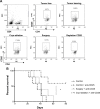Cryo-ablation improves anti-tumor immunity through recovering tumor educated dendritic cells in tumor-draining lymph nodes
- PMID: 25792805
- PMCID: PMC4362656
- DOI: 10.2147/DDDT.S76592
Cryo-ablation improves anti-tumor immunity through recovering tumor educated dendritic cells in tumor-draining lymph nodes
Abstract
Background: In addition to minimally invasive destruction of tumors, cryo-ablation of tumors to some extent modulated anti-tumor immunity. Cryo-ablated tumors in glioma mice models induced anti-tumor cellular immunologic response which increases the percentage of CD3(+) and CD4(+)T cells in blood as well as natural killer cells. As a crucial role in triggering anti-tumor immunity, dendritic cells (DCs) were educated by tumors to adopt a tolerance phenotype which helps the tumor escape from immune monitoring. This study aims to study whether cryo-ablation could influence the tolerogenic DCs, and influence anti-tumor immunity in tumor-draining lymph nodes (TDLNs).
Methods: Using the GL261 subcutaneous glioma mouse model, we created a tumor bearing group, cryo-ablation group, and surgery group. We analyzed alteration in phenotype and function of tolerogenic DCs, and evaluated the factors of anti-tumor immunity inhibition.
Results: DCs in TDLNs in GL261 subcutaneous glioma mouse model expressed tolerogenic phenotype. In contrast to surgery, cryo-ablation improved the quantity and quality of these tolerogenic DCs. Moreover, the DCs decreased the expression of intracellular interleukin-10 (IL-10) and extra-cellular IL-10. In vitro, DCs from the cryo-ablation group recovered their specific function and induced potent anti-tumor immunity through triggering T cells. In vivo, cryo-ablation showed weak anti-tumor immunity, only inhibiting the growth of rechallenged tumors. But many IL-10-low DCs, rather than IL-10-high DCs, infiltrated the tumors. More importantly, Tregs inhibited the performance of these DCs; and depletion of Tregs greatly improved anti-tumor immunity in vivo.
Conclusion: Cryo-ablation could recover function of tumor induced tolerogenic DCs in vitro; and depletion of Tregs could improve this anti-tumor effect in vivo. The Tregs/CD4(+)T and Tregs/CD25(+)T cells in TDLNs inhibit DCs' activity and function.
Keywords: anti-tumor immunity; cryo-ablation; dendritic cells; glioma; tumor-draining lymph nodes.
Figures





Similar articles
-
Induction of potent antitumor immunity by intratumoral injection of interleukin 23-transduced dendritic cells.Cancer Res. 2006 Sep 1;66(17):8887-96. doi: 10.1158/0008-5472.CAN-05-3448. Cancer Res. 2006. PMID: 16951206
-
Efficient loading of dendritic cells following cryo and radiofrequency ablation in combination with immune modulation induces anti-tumour immunity.Br J Cancer. 2006 Oct 9;95(7):896-905. doi: 10.1038/sj.bjc.6603341. Epub 2006 Sep 5. Br J Cancer. 2006. PMID: 16953240 Free PMC article.
-
Exosomes from Dendritic Cells Loaded with Chaperone-Rich Cell Lysates Elicit a Potent T Cell Immune Response Against Intracranial Glioma in Mice.J Mol Neurosci. 2015 Jul;56(3):631-43. doi: 10.1007/s12031-015-0506-9. Epub 2015 Feb 14. J Mol Neurosci. 2015. PMID: 25680514
-
Immune microenvironment of tumor-draining lymph nodes: insights for immunotherapy.Front Immunol. 2025 Apr 11;16:1562797. doi: 10.3389/fimmu.2025.1562797. eCollection 2025. Front Immunol. 2025. PMID: 40292299 Free PMC article. Review.
-
Dendritic cells in atherogenesis: possible novel targets for prevention of atherosclerosis.J Atheroscler Thromb. 2012;19(11):953-61. doi: 10.5551/jat.14134. Epub 2012 Aug 9. J Atheroscler Thromb. 2012. PMID: 22878702 Review.
Cited by
-
Cryoablation of primary breast cancer tumors induces a systemic abscopal effect altering TIME (Tumor Immune Microenvironment) in distant tumors.Front Immunol. 2024 Dec 2;15:1498942. doi: 10.3389/fimmu.2024.1498942. eCollection 2024. Front Immunol. 2024. PMID: 39703517 Free PMC article.
-
The cryo-thermal therapy eradicated melanoma in mice by eliciting CD4+ T-cell-mediated antitumor memory immune response.Cell Death Dis. 2017 Mar 23;8(3):e2703. doi: 10.1038/cddis.2017.125. Cell Death Dis. 2017. PMID: 28333145 Free PMC article.
-
Improving the Quality of Human Upper Urinary Tract Specimens by Cryobiopsy.Front Oncol. 2022 Feb 11;12:810367. doi: 10.3389/fonc.2022.810367. eCollection 2022. Front Oncol. 2022. PMID: 35223492 Free PMC article.
-
A role of eosinophils in mediating the anti-tumour effect of cryo-thermal treatment.Sci Rep. 2019 Sep 13;9(1):13214. doi: 10.1038/s41598-019-49734-5. Sci Rep. 2019. PMID: 31519961 Free PMC article.
-
Cryoablation reshapes the immune microenvironment in the distal tumor and enhances the anti-tumor immunity.Front Immunol. 2022 Aug 31;13:930461. doi: 10.3389/fimmu.2022.930461. eCollection 2022. Front Immunol. 2022. PMID: 36119081 Free PMC article.
References
-
- Banchereau J, Briere F, Caux C, et al. Immunobiology of dendritic cells. Annu Rev Immunol. 2000;18:767–811. - PubMed
-
- Sinha P, Clements VK, Bunt SK, Albelda SM, Ostrand-Rosenberg S. Cross-talk between myeloid-derived suppressor cells and macrophages subverts tumor immunity toward a type 2 response. J Immunol. 2007;179(2):977–983. - PubMed
Publication types
MeSH terms
LinkOut - more resources
Full Text Sources
Research Materials

